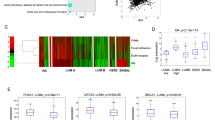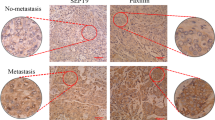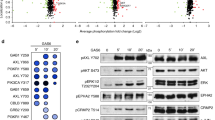Abstract
In advanced breast carcinomas, the α6β4 integrin is associated with a migratory and invasive phenotype. In our current study, we show that expression of the α6β4 integrin in MDA-MB-435 breast carcinoma cells leads to increased expression of the autocrine motility factor autotaxin, as determined by Affymetrix gene chip, real-time quantitative RT–PCR and immunoblot analyses. We further demonstrate that increased autotaxin secretion from integrin α6β4 expressing cells acts to enhance chemotaxis through its ability to convert lysophosphatidylcholine (LPC) to lysophosphatidic acid (LPA) and accounts for 80% of the motogenic activity of the conditioned medium. We determine that integrin α6β4-dependent overexpression of autotaxin in MDA-MB-435 cells is mediated by NFAT1, but not NFAT5, through the use of siRNAs that specifically target autotaxin, integrin β4, NFAT1 and NFAT5. Finally, we show by electrophoretic mobility shift assays that two consensus NFAT binding sites found in the autotaxin promoter strongly and specifically bind NFAT1 from integrin α6β4 expressing cells. In summary, we find that the α6β4 integrin potentiates autotaxin expression through the upregulation and activation of NFAT1. These observations highlight for the first time a mechanism by which NFAT transcription factors can facilitate an invasive and motile phenotype downstream of integrin α6β4 signaling.
This is a preview of subscription content, access via your institution
Access options
Subscribe to this journal
Receive 50 print issues and online access
$259.00 per year
only $5.18 per issue
Buy this article
- Purchase on Springer Link
- Instant access to full article PDF
Prices may be subject to local taxes which are calculated during checkout




Similar content being viewed by others
References
Bachelder RE, Lipscomb EA, Lin X, Wendt MA, Chadborn NH, Eickholt BJ and Mercurio AM . (2003). Cancer Res., 63, 5230–5233.
Bachelder RE, Wendt MA and Mercurio AM . (2002). Cancer Res., 62, 7203–7206.
Black EJ, Clair T, Delrow J, Neiman P and Gillespie DAF . (2004). Oncogene, 23, 2357–2366.
Chao C, Lotz MM, Clarke AC and Mercurio AM . (1996). Cancer Res., 56, 4811–4819.
Chung J, Bachelder RE, Lipscomb EA, Shaw LM and Mercurio AM . (2002). J. Cell Biol., 158, 165–174.
Clair T, Lee HY, Liotta LA and Stracke ML . (1997). J. Biol. Chem., 272, 996–1001.
Friedrichs K, Ruiz P, Franke F, Gille I, Terpe H-J and Imhof BA . (1995). Cancer Res., 55, 901–906.
Gambaletta D, Marchetti A, Benedetti L, Mercurio AM, Sacchi A and Falcioni R . (2000). J. Biol. Chem., 275, 10604–10610.
Hogan PG, Chen L, Nardone J and Rao A . (2003). Genes Dev., 17, 2205–2232.
Jauliac S, Lopex-Rodriguez C, Shaw LM, Brown LF, Rao A and Toker A . (2002). Nat. Cell Biol., 4, 540–544.
Jones JL, Royall JE, Critchley DR and Walker RA . (1997). Exp. Cell Res., 235, 325–333.
Kawagoe H, Stracke ML, Nakamura H and Sano K . (1997). Cancer Res., 57, 2516–2521.
Li J, O'Connor KL, Hellmich Jr MR, Greeley Jr GH, Townsend Jr CM and Evers BM . (2004). J. Biol. Chem., 279, 28466–28474.
Lipscomb EA, Dugan AS, Rabinovitz I and Mercurio AM . (2003). Clin. Exp. Metastasis, 20, 569–576.
Mainiero F, Colombara M, Antonini V, Strippoli R, Merola M, Poffe O, Tridente G and Ramarli D . (2003). Eur. J. Immunol., 33, 3038–3048.
Mercurio AM and Rabinovitz I . (2001). Semin. Cancer Biol., 11, 129–141.
Mills GB and Moolenaar WH . (2003). Nat. Rev. Cancer, 3, 582–591.
Mukhopadhyay R, Theriault RL and Price JE . (1999). Clin. Exp. Metastasis, 17, 325–332.
Nam SW, Clair T, Kim YS, McMarlin A, Schiffmann E, Liotta LA and Stracke ML . (2001). Cancer Res, 61, 6938–6944.
Nikolopoulos SN, Blaikie P, Yoshioka T, Guo W and Giancotti FG . (2004). Cancer Cell, 6, 471–483.
O'Connor KL, Nguyen B-K and Mercurio AM . (2000). J. Cell Biol., 148, 253–258.
O'Connor KL, Shaw LM and Mercurio AM . (1998). J. Cell Biol., 143, 1749–1760.
Rabinovitz I and Mercurio AM . (1997). J. Cell. Biol., 139, 1873–1884.
Rabinovitz I, Toker A and Mercurio AM . (1999). J. Cell Biol., 146, 1147–1159.
Shaw LM, Rabinovitz I, Wang HH-F, Toker A and Mercurio AM . (1997). Cell, 91, 949–960.
Stracke M, Krutzsch H, Unsworth E, Arestad A, Cioce V, Schiffmann E and Liotta L . (1992). J. Biol. Chem., 267, 2524–2529.
Tagliabue E, Ghirelli C, Squicciarini P, Aiello P, Colnaghi MI and Menard S . (1998). Clin. Cancer Res., 4, 407–410.
Tani T, Lumme A, Linnala A, Kivilaakso E, Kiviluoto T, Burgeson RE, Kangas L, Leivo I and Virtanen I . (1997). Am. J. Pathol., 151, 1289–1302.
Tian Y, Ke S, Denison MS, Rabson AB and Gallo MA . (1999). J. Biol. Chem., 274, 510–515.
Tokumura AME, Kariya Y, Tominaga K, Kogure K, Yasuda K and Fukuzawa K . (2002). J. Biol. Chem., 277, 39436–39442.
Umezu-Goto M, Kishi Y, Taira A, Hama K, Dohmae N, Takio K, Yamori T, Mills G, Inoue K, Aoki J and Arai H . (2002). J. Cell Biol., 158, 227–233.
Yang S, Lee J, Park C, Kim S, Hong S, Chung H, Min S, Han J, Lee H and Lee H . (2002). Clin. Exp. Metastasis, 19, 603–608.
Zahir N, Lakins JN, Russell A, Ming W, Chatterjee C, Rozenberg GI, Marinkovich MP and Weaver VM . (2003). J. Cell Biol., 163, 1397–1407.
Acknowledgements
We gratefully acknowledge Lance Liotta, Mary Stracke and Arthur Mercurio for reagents and cell lines. We also thank B Mark Evers, Sarita Sastry, Zobeida Cruz-Monserrate and Adriana Paulucci for helpful discussions and L Nicole Towers for technical assistance. This work was supported by the Center for Interdisciplinary Research in Women's Health, the Gastrointestinal Research Interdisciplinary Program, John Sealy Foundation Memorial Endowment Fund and the Sealy Center for Cancer Cell Biology.
Author information
Authors and Affiliations
Corresponding author
Rights and permissions
About this article
Cite this article
Chen, M., O'Connor, K. Integrin α6β4 promotes expression of autotaxin/ENPP2 autocrine motility factor in breast carcinoma cells. Oncogene 24, 5125–5130 (2005). https://doi.org/10.1038/sj.onc.1208729
Received:
Revised:
Accepted:
Published:
Issue Date:
DOI: https://doi.org/10.1038/sj.onc.1208729
Keywords
This article is cited by
-
Loss of FOXF1 expression promotes human lung-resident mesenchymal stromal cell migration via ATX/LPA/LPA1 signaling axis
Scientific Reports (2020)
-
Transcriptome profiling reveals PDZ binding kinase as a novel biomarker in peritumoral brain zone of glioblastoma
Journal of Neuro-Oncology (2019)
-
Integrin α6β4 Upregulates Amphiregulin and Epiregulin through Base Excision Repair-Mediated DNA Demethylation and Promotes Genome-wide DNA Hypomethylation
Scientific Reports (2017)
-
A Molecular View of Pathological Microcalcification in Breast Cancer
Journal of Mammary Gland Biology and Neoplasia (2016)
-
Autotaxin is induced by TSA through HDAC3 and HDAC7 inhibition and antagonizes the TSA-induced cell apoptosis
Molecular Cancer (2011)



